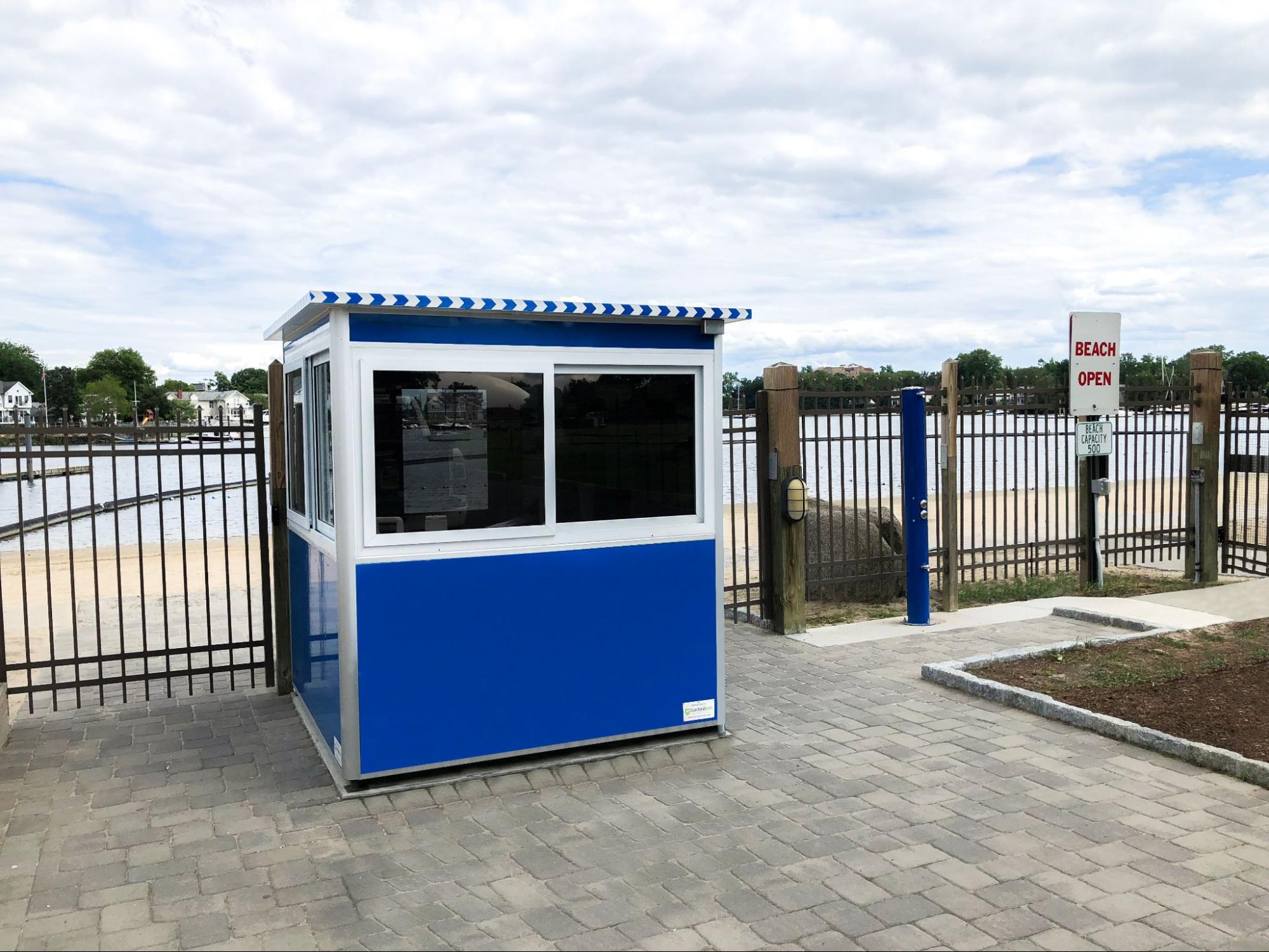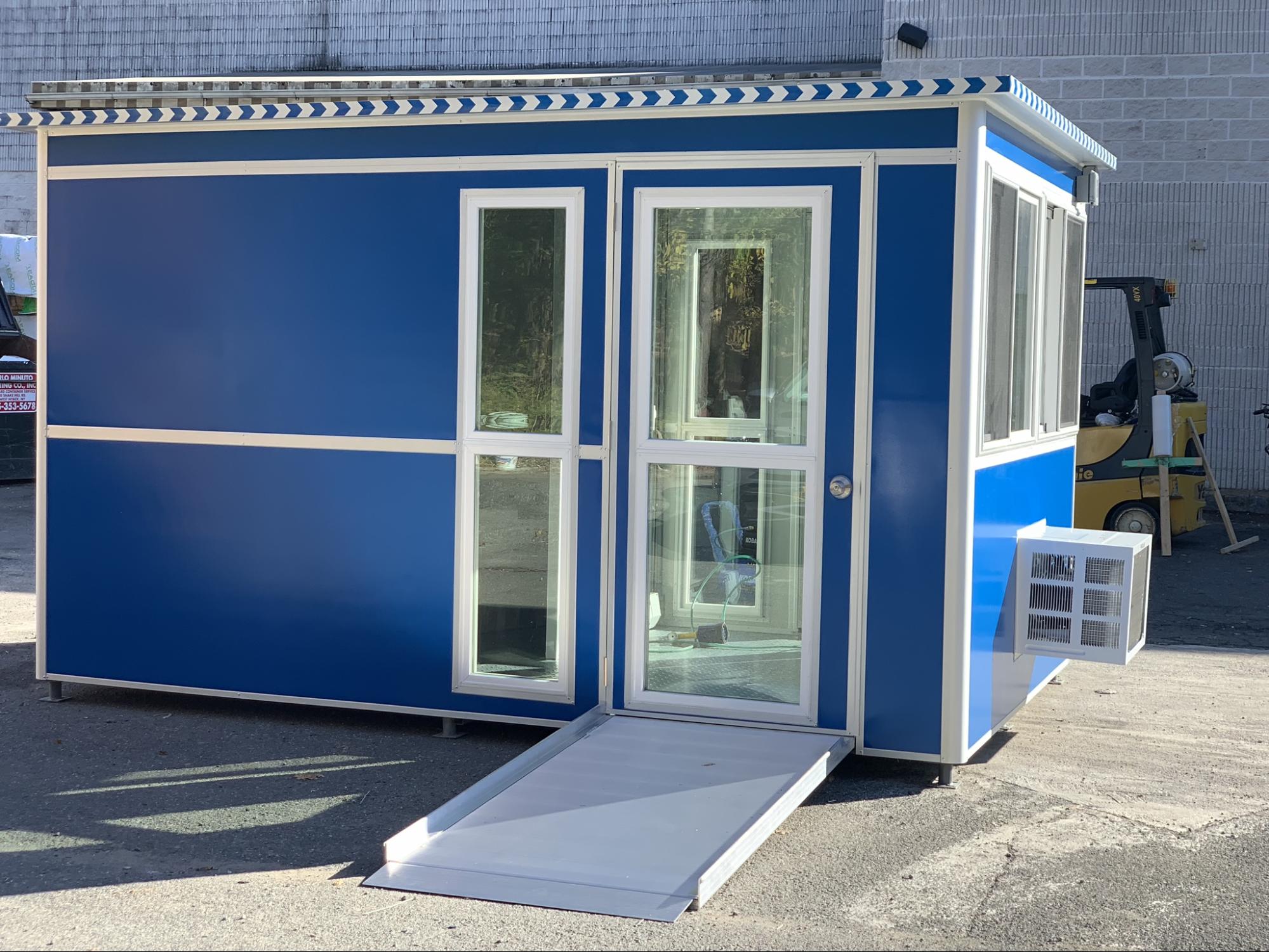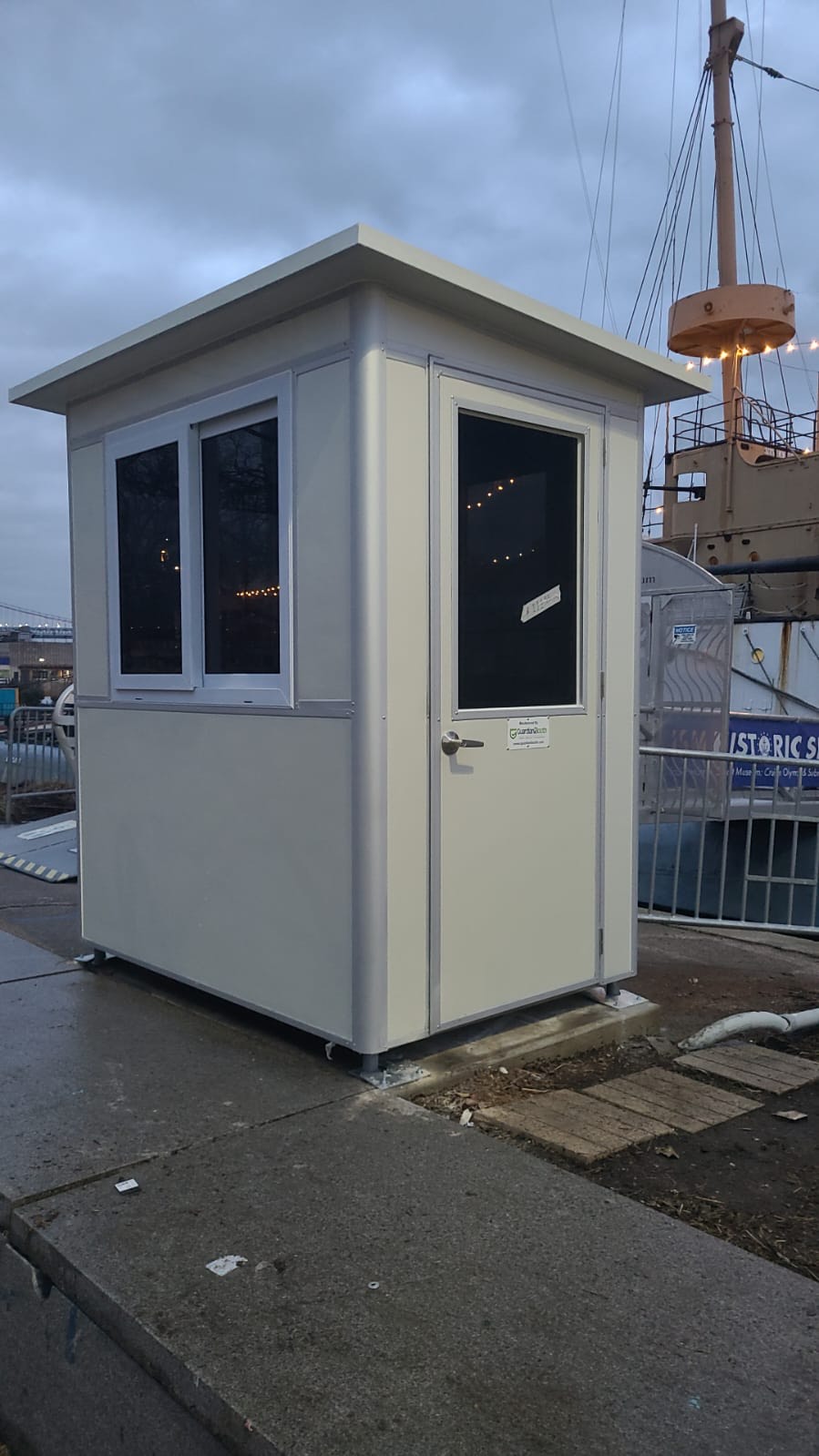Maintaining secure shipping ports is paramount in today’s global trade landscape, and temporary guard shacks offer a versatile solution. These mobile units can be strategically positioned at key entry points to monitor incoming and outgoing traffic, ensuring enhanced security.
Equipped with advanced surveillance technology, these guard shacks provide real-time monitoring, making them an ideal deterrent against unauthorized access and cargo theft. From tracking shipments to deterring potential threats, these guard shacks are crucial to safeguarding your port’s assets and ensuring seamless operations in an ever-evolving landscape.
But what makes these temporary guard shacks truly invaluable is their mobility.
Stay tuned as we delve deeper into how the adaptability of a modular guard shack allows you to fortify your shipping port security while maintaining operational flexibility.
Importance of Securing Shipping Ports
Securing shipping ports is of paramount importance in today’s global economy. These hubs are lifelines for trade, handling massive volumes of goods daily. Failing to secure them can lead to severe consequences, including theft, terrorism, and economic disruption.
Boosting security involves implementing physical measures like fencing, access control, surveillance, and cybersecurity to protect vital digital systems. Adequate protection ensures the flow of goods remains uninterrupted, safeguarding the economy and the nation’s safety.
Moreover, shipping ports often handle sensitive cargo, including hazardous materials and critical infrastructure components. Neglecting security measures can put lives at risk and leave the surroundings vulnerable to catastrophic events. In an era of heightened security threats, securing shipping ports is a priority and imperative for global commerce and national security.
Role of Guard Shacks in Enhancing Security
Guard shacks enhance security across various industries, including shipping ports. The advantages of these guard shacks extend beyond convenience; they significantly bolster security by serving as a visible deterrent to potential intruders.
- Portable guard shacks provide security personnel with a centralized location to monitor and control entry, contributing to a proactive security approach. Portable booths, equipped with rolling wheels, offer the added advantage of easy relocation to address changing security needs effectively.
- Trailer-mounted portable guard shacks provide unparalleled versatility and adaptability, allowing security teams to respond promptly to shifting threats or incidents across the expansive port. Equipped with wheels or towing capabilities, these mobile units are designed for constant relocation to areas needing immediate security attention, ensuring agile and effective incident response throughout the port facility.
With advanced surveillance technology, communication systems, and access control features, guard shacks empower security personnel to conduct rigorous checks and maintain an efficient flow of authorized personnel and cargo.
In the dynamic world of shipping port security, these guard shacks are indispensable tools that help ensure the safe and uninterrupted flow of goods while deterring unauthorized access and potential threats.
Assessing Security Needs at Shipping Ports
Assessing security needs at shipping ports is a critical first step in safeguarding these vital global trade hubs. Understanding the unique threats and vulnerabilities specific to each port is paramount.
Stay tuned as we delve into the critical role of guard shacks, custom-tailored to address specific security needs. These structures are pivotal in fortifying port security against unauthorized access, smuggling, vandalism, and potential terrorist activities. Their strategic placement and advanced surveillance capabilities are essential in maintaining seamless operations in an ever-evolving security landscape.

Identifying Potential Vulnerabilities
Numerous parts of a shipping port can be at risk of security vulnerabilities, and strategically placing booths can effectively address these needs. Here are several key areas and how a temporary guard shack can enhance security:
- Entrance and Exit Gates: Entrance and exit gates are critical points where unauthorized access can occur. Placing a security booth here enables personnel to monitor and control incoming and outgoing traffic, verifying credentials and enhancing access control.
- Container Storage Yards: These areas often house valuable cargo and can be susceptible to theft or tampering. Security booths placed at entry points of container storage yards allow for efficient monitoring, screening, and inspection of containers, reducing the risk of unauthorized access and cargo loss.
- Perimeter Fencing: A prefabricated security booth positioned at the perimeter fencing can serve as a lookout point, deterring potential intruders and providing a vantage point for monitoring the surrounding area.
- Maintenance and Repair Facilities: These areas often contain valuable equipment and machinery. Placing a security booth at the entrance enhances access control, ensuring only authorized personnel enter and preventing theft or damage.
- Fuel and Hazardous Material Storage: The security of fuel and hazardous material storage is crucial. A booth at these locations allows continuous monitoring, ensuring only authorized individuals access these sensitive areas.
- Loading and Unloading Zones: Security booths positioned at loading and unloading zones enable efficient monitoring of cargo handling, verifying the integrity of shipments, and preventing unauthorized access.
- Remote or Isolated Areas: Some parts of a shipping port may be isolated or less frequented, making them vulnerable to unauthorized entry. Placing a security booth in these areas ensures they are not overlooked, and potential security breaches are promptly addressed.
- Traffic Control: Security booths can be placed at key intersections within the port to regulate traffic flow. This not only enhances security but also prevents congestion and accidents.
- Office and Administrative Areas: Administrative areas can contain sensitive information and resources. Placing security booths at entry points helps control access and ensures that only authorized personnel enter these spaces.
- Docks and Berths: Placing security booths near docks and berths allows for real-time monitoring of vessel arrivals, cargo handling, and port activities, helping prevent security incidents and ensuring efficient operations.
Strategically positioning security booths in these vulnerable areas of a shipping port strengthens access control, deters potential threats, and enhances overall security, contributing to a safer and more efficient port environment.
Analyzing Existing Security Measures at Shipping Ports
Analyzing existing security measures at shipping ports is a critical task for a port manager to ensure the safety and integrity of operations. Here are the steps a port manager should take in this process:
- Assess Current Security Protocols: Begin by reviewing and assessing the current security protocols and procedures. This includes physical security measures, access control, surveillance systems, and personnel roles and responsibilities.
- Conduct a Risk Assessment: Conduct a comprehensive risk assessment to identify potential security vulnerabilities. This should involve evaluating the different aspects of port operations, from cargo handling to personnel access, and pinpointing areas where security risks are most significant.
- Check for Regulatory Compliance: Ensure the port complies with relevant local, national, and international security regulations. This may include adherence to the International Ship and Port Facility Security (ISPS) Code or other industry-specific standards.
- Evaluate Security Technology and Infrastructure: Examine the effectiveness of existing security technology and infrastructure, such as surveillance cameras, access control systems, and alarm systems. Determine if these systems are up to date and functioning optimally.
- Review Personnel Training and Awareness: Review the training and awareness programs for security personnel. Ensure that security staff is well-informed about security procedures and protocols and regularly trained to handle evolving security threats.
- Evaluate Incident Reporting and Response: Analyze the incident reporting and response mechanisms in place. Evaluate the effectiveness of response times and communication during security incidents.
- Implement Physical Security Measures: Inspect physical security measures, including barriers, fencing, lighting, and access points. Assess the need for enhancements or repairs to fortify the port’s physical security.
- Tighten Access Control: Examine the procedures for controlling access to the port and its various areas. Ensure access is limited to authorized personnel and the access control system is reliable.
- Consider Surveillance and Monitoring: Evaluate the coverage and quality of surveillance and monitoring systems. Consider whether additional cameras or sensors are needed in certain areas.
- Review the Security Budget: Review the budget allocated to security measures and assess whether it is sufficient to address existing and potential security risks. Identify areas where additional resources may be needed.
- Get Feedback from Stakeholders: Gather input from stakeholders, including security personnel, port employees, and relevant authorities. Their insights and feedback can provide valuable perspectives on existing security measures.
Following these steps, a port manager can thoroughly analyze existing security measures and take proactive steps to strengthen security and safeguard the shipping port against potential threats and vulnerabilities.
Determining the Need for Temporary Guard Shacks
In assessing security needs and optimizing protection, understanding the requirement for temporary guard shacks becomes a pivotal consideration.
Here’s how to do it:
- Consider the Level of Security Required at the Shipping Port
Begin by defining the specific security needs of the shipping port. The level of security required can vary significantly depending on factors like the type of cargo handled, the port’s location, and its historical security incidents.
Determine the critical assets that need protection, including cargo, equipment, infrastructure, and personnel. The security level should align with the value and sensitivity of these assets. - Assess the Frequency and Nature of Security Incidents or Breaches
Review historical data on security incidents or breaches at the port. This analysis will provide insight into the nature and frequency of security threats the port has faced.Identify trends and patterns in past incidents to better understand the vulnerabilities and risks unique to the port.
- Evaluate the Potential Benefits of Having a Physical Presence at Key Entry Points
Determine whether it would be advantageous to have a physical security presence at key entry points. Security booths placed strategically at these locations can act as a visible deterrent to potential intruders.A physical presence can facilitate efficient access control, visitor screening, and incident response.
- View the Implementation of Temporary Guard Shacks as a Proactive Investment
Consider temporary guard shacks as a proactive investment to enhance security. These structures offer a quick and effective solution to address immediate security needs or emerging risks.Guard shacks can be deployed rapidly in vulnerable or high-traffic areas, providing a controlled environment for security personnel to monitor, control access, and respond to security incidents.
- Consult with Guardian Booth’s Security Experts
Guardian Booth’s security experts have extensive experience in providing solutions for enhancing security at shipping ports. Leveraging their expertise can be invaluable in making informed decisions.
Consultation with Guardian Booth’s experts can help port managers identify the most suitable locations for security booths, determine the optimal design and features, and understand how these structures can complement existing security measures.
In summary, the security of a shipping port requires a comprehensive and tailored approach. Assessing security needs, understanding past incidents, and considering proactive solutions like security booths are essential to fortifying the port’s defenses. Guardian Booth’s experts can guide the implementation of these security solutions, offering insights and recommendations to ensure that the security measures align with the port’s unique requirements and vulnerabilities.
Selecting the Right Temporary Guard Shack
Selecting the right temporary guard shack is essential for adequate port security, and understanding key factors is vital in ensuring a successful protection strategy.
Here are some factors to consider:
- Location: Strategically place the guard shack to cover vulnerable access points and high-traffic areas within the port. Consider the shack’s role in access control and incident prevention.
- Size: Opt for a size that comfortably accommodates security personnel and necessary equipment. Adequate space ensures efficient operations and accessibility within the shack.
- Mobility: Evaluate whether mobility is required based on your port’s operational dynamics. Mobile guard shacks offer flexibility and adaptability.
- Technology Integration: Consider integrating technology, including surveillance systems, communication tools, and access control technology. The guard shack should support seamless connectivity with existing security infrastructure.
- Durability: Assess the durability of the guard shack, especially in the maritime environment. It should be constructed from materials that withstand harsh conditions, including exposure to saltwater and weather extremes.
- Evaluating Size and Layout Requirements: When assessing the size and layout requirements, planning for the present and anticipating future needs is essential. This includes considering:
- Personnel Growth: Account for potential growth in security personnel over time. The guard shack should be designed to accommodate an expanding security team without compromising functionality.
- Equipment and Technology: Anticipate the addition of new equipment and technology within the guard shack. Ensure sufficient space for surveillance equipment, communication systems, and access control tools.
- Comprehensive Area Security: The layout should support comprehensive area security at the time of installation and as the port evolves. The guard shack should allow for effective monitoring of a wide area.
- Climate Control: Climate control systems, including heating and air conditioning, can provide a comfortable working environment for security personnel, ensuring their efficiency year-round.
- Access Control Systems: Implement advanced access control systems to regulate entry and exit, ensuring only authorized personnel gain access.
Tailoring the guard shack to your particular requirements is an effective way to safeguard your port. It ensures that the guard shack is a security asset and a strategic element of your port’s comprehensive security plan. Guardian Booth can provide guidance and customization options to meet these requirements effectively.

Setting up Portable Guard Shacks at Shipping Ports
Explore the logistical process of delivering and setting up these mobile units and how they shape the future of port protection.
Site preparation and installation considerations
The installation of a temporary guard shack at a shipping port involves several important site preparation and installation considerations to ensure that it functions effectively. Here are some key factors to remember:
- Site Selection: Choose the optimal location for the guard shack. Consider strategic placement to cover vulnerable access points, high-traffic areas, and areas requiring close monitoring.
- Permits and Approvals: Check whether permits or approvals are required for installing the temporary guard shack. Regulatory compliance is essential, especially in a port setting.
- Foundation Preparation: The foundation may vary depending on whether the temporary guard shack is mobile or stationary. For mobile guard shacks, a level surface is typically sufficient. Stationary guard shacks may require extensive foundation work, such as concrete footings, to ensure stability and durability.
- Utility Connections: Ensure that necessary utility connections are available. These may include electrical power, data connections, water supply for climate control systems, communication equipment, and other utilities within the guard shack.
- Environmental Considerations: Consider the port’s unique environmental conditions. Shipping ports are often exposed to harsh weather and saltwater. The guard shack’s construction and materials should be suitable for these conditions, including resistance to corrosion and weatherproofing.
- Security Perimeter: Establish a security perimeter around the guard shack. This may involve fencing, barriers, or access control measures to control and restrict access to the guard shack area.
- Integration with Security Systems: Ensure the guard shack seamlessly integrates with the port’s security systems. This includes connections to surveillance cameras, communication networks, and access control systems.
A shipping port can effectively integrate a temporary guard shack into its security infrastructure by carefully addressing these site preparation and installation considerations. This enhances security and contributes to the overall safety and efficiency of port operations. Guardian Booth’s expertise in security solutions can be a valuable resource during this process.
Connecting utilities and ensuring functionality
Ensuring the functionality of guard shacks at shipping ports hinges on efficient utility connections. This encompasses electrical wiring and outlets for security equipment and systems, a responsibility typically managed by Guardian Booth.
Simultaneously, setting up a reliable communication system, like phone lines and intercoms, involves coordination with both parties to ensure seamless communication among security personnel.
Collaborative efforts between the client and Guardian Booth are vital to optimize the effectiveness of the guard shack in safeguarding the port. Proper utility connections act as the lifeline, allowing these structures to fulfill their security roles effectively.
Implementing security measures within the guard shack
Implementing security measures within a temporary guard shack is crucial for maintaining a safe and secure shipping port environment. Port managers should consider the following steps to ensure adequate security measures:
- Access Control: Implement access control measures to regulate entry and exit at the guard shack. This may include electronic key card systems, biometric scanners, or traditional security personnel checking identification and credentials.
- Surveillance Systems: Install surveillance cameras inside and outside the guard shack. This provides real-time monitoring of activities in the vicinity and helps identify security threats or incidents.
- Communication Equipment: Equip the guard shack with reliable communication tools such as two-way radios, intercom systems, and phone lines. Effective communication is essential for coordinating responses to security incidents.
- Alarm Systems: Install alarm systems to detect unauthorized access, breaches, or security breaches. Alarm systems can alert security personnel or trigger automated responses in case of an incident.
- Lighting: Ensure proper lighting in and around the guard shack, especially during night shifts. Well-illuminated areas discourage unauthorized activities and improve visibility for security personnel.
- Panic Buttons: Provide panic buttons or emergency alarms within the guard shack to allow security personnel to request immediate assistance in case of a security threat or emergency.
- Surveillance Monitors: Install monitors or displays within the guard shack for security personnel to view live camera feeds, access control data, and alarm notifications.
- Visitor Screening: Implement visitor screening protocols for all individuals seeking access to the port. This may involve identification checks, vehicle inspections, and the issuance of visitor passes.
- Regular Security Briefings: Conduct regular security briefings and updates for security personnel working in the guard shack. Keep them informed about the latest security protocols and potential threats.
- Documentation and Reporting: Maintain detailed records of security incidents, breaches, or suspicious activities. This documentation can aid in investigations and improvements to security measures.
- Personnel Training: Continuously train security personnel on security best practices, including updated security technologies and procedures.
By implementing these security measures within the temporary guard shack, a port manager can significantly enhance the security and safety of the shipping port. Adequate security measures not only protect assets and personnel but also contribute to the overall efficiency and functionality of the port. Guardian Booth’s expertise in security solutions can provide valuable insights and resources for achieving these security objectives.
Furnishing the guard shack for optimal functionality
Furnishing the guard shack is essential for optimal functionality in securing shipping ports, which includes providing ergonomic furniture to enhance guards’ comfort and productivity during long shifts.
When furnishing a temporary guard shack, it’s essential to prioritize the ergonomic design of the workspace. Start by arranging furniture, workstations, and equipment to promote an efficient workflow. Ergonomically designed chairs, workstations, and computer terminals can significantly reduce the risk of discomfort and fatigue for security personnel who may spend long hours on duty. This not only enhances their productivity but also contributes to their overall well-being, ensuring they can stay alert and focused during their shifts.
The portable guard shack should be equipped with advanced communication tools to support the security team’s operations. This includes two-way radios, intercom systems, and computer terminals. Ensure that these devices are easily accessible and strategically placed to facilitate effective communication and coordination among security personnel.
Consider the comfort and well-being of security personnel by installing climate control systems, such as air conditioning and heating units, to maintain a pleasant working environment throughout the year.
Additionally, it’s beneficial to provide personal amenities within or near the guard shack, including restrooms, break areas, and refreshment facilities.
By addressing these needs, you reduce the necessity for security personnel to leave the station during their shifts, thus ensuring that the guard shack remains a central and efficient hub for security operations.
Establishing signage and visibility
The establishment of signage and visibility are integral elements in deploying guard shacks. Visible signage not only indicates the presence of a guard shack but can also incorporate branding elements, reinforcing the security message and corporate identity.
Proper lighting and reflective materials ensure visibility, especially during nighttime hours. This illumination is pivotal in maintaining adequate security operations and discouraging potential intruders while enhancing the security presence’s professionalism and recognizability.
Conducting a final inspection and testing
Conducting a final inspection and testing is the last crucial step in preparing a guard shack for service at shipping ports. It involves verifying the functionality of all installed systems and equipment, including surveillance, access control, and lighting. Rigorous testing of communication systems and alarms ensures they operate effectively.
It’s paramount to confirm that all safety and security measures are in place before deploying guards to the shack, guaranteeing the facility’s readiness to safeguard the port’s vital entry points and assets.





